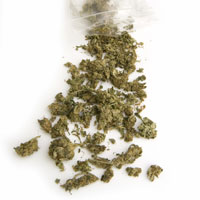Called K2, Spice, Incense, or Mr. Smiley among many others, synthetic cannabis is actually a collection of dry herbs and plant pieces sprayed with a chemical that is up to 100 times stronger than natural marijuana. It sounds so innocuous, yet on the back of the colorful packaging is printed a warning – “Not for human consumption. Meant as a potpourri mixture only” – yet labeled with such names as bubblegum and raspberry flavored. It can be obtained at many head or smoke shops, the Internet or convenience stores, yet emergency rooms are being flooded with overdoses and those young people suffering from bad trips thanks to the psychoactive effects.
How It Works
Like many of the street drugs today, Spice is an ever-changing cocktail blend of chemicals, simply under the guise of a natural substance, yet most likely more harmful than the real plant. Having debuted in the early 2000s, legal bud does not trigger a positive on the urine tests for marijuana and is marketed as all-natural, as though the high comes from an organic source. In reality there is nothing natural about it: all of the fake weed contains what is called cannabinoids, or synthetic cannabis, originally produced in labs as a method for scientists to measure the reaction of the brain on cannabis. Cannabinoids are as yet still legal but extremely little is known about them or their far-reaching effects on the human body and mind. Wisely, many of the companies making the fake stuff place disclaimers on their product and some stores will even make you sign a waiver if you buy from them. These waivers absolve the shop from liability should the user be injured or die as a result.
Due to the ever-changing nature of the chemicals used on the ‘herbs’, the effects can vary from small foil pouch to small foil pouch. It does appear that the end result is similar to a marijuana high, but savvy users have noticed a difference. Some claim the high is more of an all-over relaxation than marijuana, and others have noted that smoking the fake shake is quite painful to the lungs and throat even well after smoking is done. While it affects the brain in a way similar to marijuana, complete with altered perception, elevated mood, and relaxation, some experience worse symptoms: extreme anxiety, paranoia, hallucinations, and other psychotic effects. The consensus is that the high does not last as long as the real deal. Most agree it tastes terrible.
The original fake bud contained a synthetic called HU-210, which was very similar in molecular structure to THC, the active ingredient in marijuana. It was listed as a controlled substance in the United States, so the product was only created and distributed in Europe and abroad. With the creation of new synthetic chemicals, namely CP 47,497 and JWH-018, which are not structurally similar to THC, the herbal incense is free to be sold legally in the States. Despite the difference in structure, the substance still attaches itself to the CB, or cannabinoid, receptors in the brain, like it does with THC. The biggest difference between THC and the synthetics is the potency level. It appears that the chemicals in Spice bind better and with greater strength to the receptors than naturally occurring THC, causing reactions different than the user might expect.
So What’s the Problem?
The problem stems from the unknown factors in the chemicals used for the high. There’s also the problem of the emergency room rushes that have risen significantly. The FBI revealed that in 2009 there were a scant 13 cases of artificial marijuana sending users into the ER. Compare that number to 560 in the first half of 2010 alone. Either more people are turning to this legal high, or the chemical cocktail is becoming more unstable. At best, it’s unpredictable. The foil packets contain pieces of plant material that could be woodchips, possibly even toxic flowers. This is either smoked like traditional marijuana or hot brewed into a tea infusion for drinking.
Next to marijuana, herbal smoke is the preferred drug of choice among high school males. In 2012, a study showed twice as many young men in 12th grade reported past-year usage of Incense as compared to females. Despite the legality of Spice, the dangers in the unknown chemicals are inherent. Generally speaking, real marijuana does not usually induce vomiting, agitation, or hallucinations, though certainly some may have experienced this individually. In a few cases, Spice has raised blood pressure and limited blood to the heart, resulting in a heart attack. Regular users have reported dependency and withdrawal symptoms.
In the end, too little is known about the current state of the drug and the long-term effects, though certainly anything inhaled in a burning form is known to be less than healthy for the lungs and throat. There is no real ‘safe side’ where drugs are concerned, they are all poisons, but educating your child is a smart step in the right direction.








